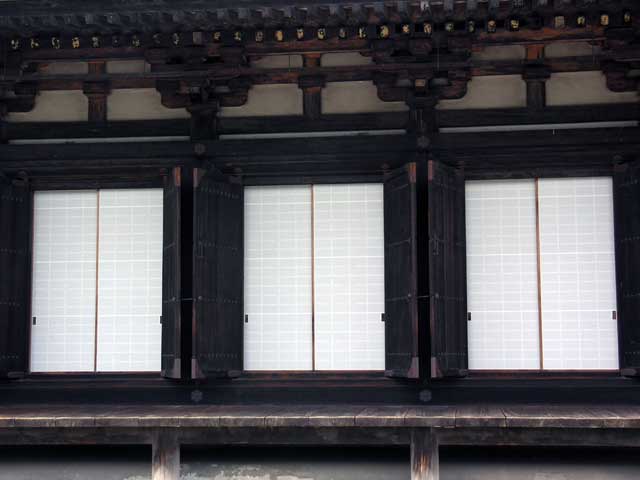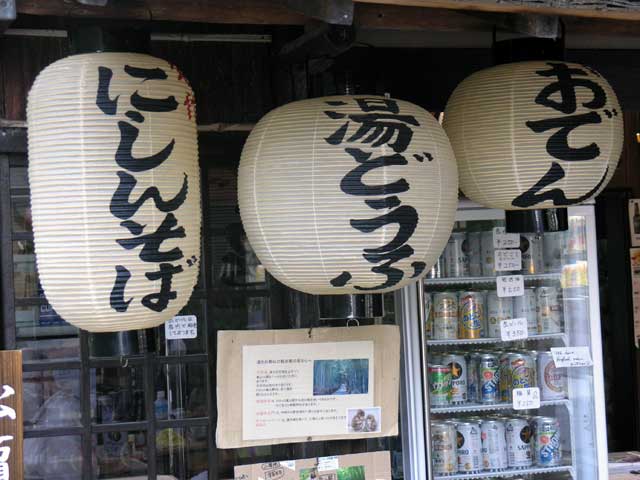
hree of a multitude a paper screens at the Sanjūsangen-dō Temple.

After breakfast and armed with bus passes for the day, we trooped off to the local bus stop and watched several packed ones go by. Given that the terminus at Kyōto Station was so close, we decided to walk and board the bus there. The first stop was the Sanjūsangen-dō temple with its 1,001 statues of Buddha – a rather impressive display in a very long hall. (Alas, no photography allowed.) We were swarmed by chattering schoolchildren as we were carried along in the flow of the youth by the ancient display.
Outside we were approached by a half dozen of the schoolchildren wanting to practice their English as their teacher watched. So we answered their questions, signed their workbooks, and posed for a picture. They gave us several small origami pieces in appreciation.
We checked out the Kyōto National Museum across the street, but found it closed for renovations except for their special exhibitions. Mason and Mike felt it wasn’t worth the effort as the main collections was what we wanted to see. So crowding onto the city bus, we got off at the foot of the hills on the east side of town that was home to a number of temples, and a number of other sites. We walked up the hill, then up the stairs to the Kiyomizu Temple, which was also mobbed with schoolchildren. Circling the grounds while taking in the view took us to lunchtime. We stopped at a small restaurant on the way back down the hill where Jonathan and I both had curry with rice. The real attraction of the restaurant was the ice cream desserts of which we all partook.
Mike’s Kyōto guide identified “the most beautiful street” in Kyōto as being in this area. It’s a short, narrow (alley – no cars) that is immaculately kept and indeed very beautiful, although I though a number of the streets we had walked in Kyōto were as beautiful in their own ways.
We visited the Kōdai-ji Temple also. Jonathan and I sat outside with some pots of lotus and water lilies (one had a huge bud showing red) while Cindy, Mike, and Mason entered the temple. The drone of the chanting was audible in the courtyard and I drowsed a bit.
Continuing along the side of the hill we found the main drag where we took the subway, then a train from the hills on the east side of the city to the hills on the west of the city to an area called Arashiyama where the river flows out of the hills. Our destination was the Sagano bamboo forest and the trail through it.
Hopping off the train, we found the path to the bamboo right from the station. The path follows streets until near the huge stand of bamboo. Photography was a challenge with the shadows as it had been all day with the bright sunlight. We followed the trail through the bamboo down to the river where we found a small restaurant where we sat outside with our beer (good idea Mason!) and edamame watching hawk, heron, and other birds against the green backdrop of the hillside across the river.
As we left we were chatted up by a Canadian ex-pat named Robert who has lived in Japan for 35 years. He made some interesting suggestions about visiting Japan’s southern islands where there are sandy beaches without the crowds.
Returning to the train station we went all the way into Kyōto Station as we were looking for a particular restaurant a couple blocks from the station. The one we found did not match the name in the guidebook, but we got “ringside” seats at the bar where I watched the cooks ply their trade. It was great fun to sip wine while watching the show. I ordered an onion pancake that was laced with calamari while Mason and Mike sampled the sake (including a sake sangria that Cindy suggested the should reproduce for cocktail hour in Pine Point this summer).
We got back to the ryokan before 2200 and went right to bed.

Paper lanterns, and more importantly the beer cooler, at the riverside restuarant at the end of the trail.